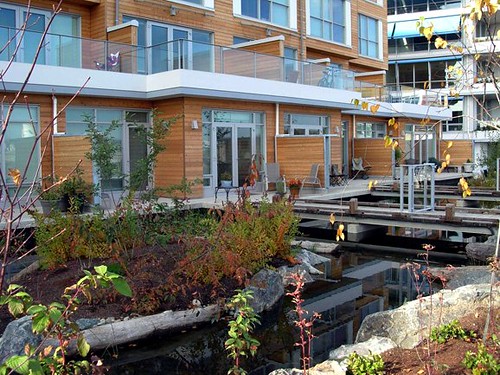A recent article in The Atlantic (online, anyway) highlights a new LEED-Platinum certified neighborhood…. yes, the entire neighborhood…. in Victoria, British Columbia. Dockside Green is a 15-acre brownfield redevelopment just across the river from downtown, powered by an onsite biomass gasification plant and treating its wastewater through a constructed waterway. The pictures certainly make it look like the coolest place to live EVER:
However Kaid Benfield (the author) said it didn’t yet feel like a “neighborhood”, perhaps due to its unfinished and half-empty status. He cites both the lack of “critical mass” and the disconnectedness to surrounding neighborhoods as reasons for the feelings of isolation, and I have no doubt that these are the main contributors. In fact, I would argue that the lack of critical mass is far more to blame than the “work in progress” status of the development. And of course, it isn’t just a matter of not having enough humans occupying the space, but enough people who are committed to the goals of the project. Bad neighbors do not make a neighborhood any more sustainable (or desirable) than no neighbors.
Humans are intensely social creatures; if we are unable (or unwilling) to socialize face-of-face, we find new and clever ways to communicate anyway, from smoke signals to virtual worlds. Regardless of how amazing and lovely our dwellings are, without neighbors willing to be neighborly we simply don’t have a neighborhood. It may be that it will take another decade or so before there are enough people of like minds who will create a community in the Dockside Green neighborhood; it seems to have taken that long in other ecovillages such as Prairie Crossing in Grayslake, IL (begun in the mid-1980’s) or the EcoVillage in Ithaca, NY (begun in the mid-1990’s). However, both of these communities have very explicit expectations for social responsibility of all of its residents, going far beyond the restrictions common to homeowner associations, and both of these communities are quite small relative to the Dockside Green effort: 400 homes in Prairie Crossing and 90 homes (60 completed) in the Ithaca EcoVillage, in contrast to the 2500 residents in 26 buildings expected when Dockside Green is completed. It will be interesting to see if this many residents can coalesce into a sustainable neighborhood!
